Teaching Experience as a Key Factor in Dealing with Digital Teaching Stress
Abstract
1. Introduction
- Q1: What are the changes that the pandemic generated in the self-concept of digital competence of the participating teachers, as well as on their assessment of the professional aspects linked to the process of digitization of teaching and their self-perceived levels of digital stress?
- Q2: How does the teaching experience of the professors influence the above assessments?
- Q3: How does the knowledge area (scientific–technical areas or humanistic–social areas) influence the ratings expressed?
2. Materials and Methods
2.1. Participants and Data Collection
2.2. Research Variables
2.3. Instrument
2.4. Statistical Analysis
3. Results
3.1. Distribution of Participants
3.2. Instrument Validity
3.3. Analysis of Responses
4. Discussion
5. Conclusions
Author Contributions
Funding
Institutional Review Board Statement
Informed Consent Statement
Data Availability Statement
Conflicts of Interest
References
- Sahu, P. Closure of Universities Due to Coronavirus Disease 2019 (COVID-19): Impact on Education and Mental Health of Students and Academic Staff. Cureus 2020, 12, e7541. [Google Scholar] [CrossRef]
- Pradhan, A.; Prabhu, S.; Chadaga, K.; Sengupta, S.; Nath, G. Supervised Learning Models for the Preliminary Detection of COVID-19 in Patients Using Demographic and Epidemiological Parameters. Information 2022, 13, 7. [Google Scholar] [CrossRef]
- Akour, A.; Al-Tammemi, A.B.; Barakat, M.; Kanj, R.; Fakhouri, H.N.; Malkawi, A.; Musleh, G. The Impact of the COVID-19 Pandemic and Emergency Distance Teaching on the Psychological Status of University Teachers: A Cross-Sectional Study in Jordan. Am. J. Trop. Med. Hyg. 2020, 103, 2391–2399. [Google Scholar] [CrossRef]
- Alonso-García, M.; Garrido-Letrán, T.M.; Sánchez-Alzola, A. Impact of COVID-19 on Educational Sustainability. Initial Perceptions of the University Community of the University of Cádiz. Sustainability 2021, 13, 11. [Google Scholar] [CrossRef]
- Rabaglietti, E.; Lattke, L.S.; Tesauri, B.; Settanni, M.; De Lorenzo, A. A Balancing Act During COVID-19: Teachers’ Self-Efficacy, Perception of Stress in the Distance Learning Experience. Front. Psychol. 2021, 12, 644108. Available online: https://www.frontiersin.org/articles/10.3389/fpsyg.2021.644108 (accessed on 16 July 2024). [CrossRef]
- Verma, G.; Campbell, T.; Melville, W.; Park, B.-Y. Science Teacher Education in the Times of the COVID-19 Pandemic. J. Sci. Teach. Educ. 2020, 31, 483–490. [Google Scholar] [CrossRef]
- Vergara-Rodríguez, D.; Antón-Sancho, Á.; Fernández-Arias, P. Variables Influencing Professors’ Adaptation to Digital Learning Environments during the COVID-19 Pandemic. Int. J. Environ. Res. Public Health 2022, 19, 6. [Google Scholar] [CrossRef]
- Gupta, R.; Aggarwal, A.; Sable, D.; Chahar, P.; Sharma, A.; Kumari, A.; Maji, R. COVID-19 Pandemic and Online Education: Impact on Students, Parents and Teachers. J. Hum. Behav. Soc. Environ. 2022, 32, 426–449. [Google Scholar] [CrossRef]
- Collie, R.J. COVID-19 and Teachers’ Somatic Burden, Stress, and Emotional Exhaustion: Examining the Role of Principal Leadership and Workplace Buoyancy. AERA Open 2021, 7, 2332858420986187. [Google Scholar] [CrossRef]
- Mesurado, B.; Laudadío, J. Teaching Experience, Psychological Capital and Work Engagement. Their Relationship with the Burnout on University Teachers. Propos. Represent. 2019, 7, 12. [Google Scholar] [CrossRef]
- Puertas-Molero, P.; Zurita-Ortega, F.; Chacón-Cuberos, R.; Martínez-Martínez, A.; Castro-Sánchez, M.; González-Valero, G. An Explanatory Model of Emotional Intelligence and Its Association with Stress, Burnout Syndrome, and Non-Verbal Communication in the University Teachers. J. Clin. Med. 2018, 7, 12. [Google Scholar] [CrossRef]
- Mérida-López, S.; Extremera, N. Emotional intelligence and teacher burnout: A systematic review. Int. J. Educ. Res. 2017, 85, 121–130. [Google Scholar] [CrossRef]
- MacIntyre, P.D.; Gregersen, T.; Mercer, S. Language teachers’ coping strategies during the COVID-19 conversion to online teaching: Correlations with stress, wellbeing and negative emotions. System 2020, 94, 102352. [Google Scholar] [CrossRef]
- Luy-Montejo, C.A.; Quispe, J.T.; Rivera, W.R.; Quispe, T.R.; Ramos, A.D.; Chávez, D.A.; Aguinaga-Villegas, D.; Gálvez-Suarez, E. Ananalysis of Latin American Scientific Production on Teacher Stress (2010–2018). Propos. Represent. 2019, 7, 3. [Google Scholar] [CrossRef]
- Madaliyeva, Z.; Mynbayeva, A.; Sadvakassova, Z.; Zholdassova, M. Correction of Burnout in Teachers. Procedia Soc. Behav. Sci. 2015, 171, 1345–1352. [Google Scholar] [CrossRef][Green Version]
- Alvites-Huamaní, C.G. Teacher Stress and Psychosocial Factors in Teachers from Latin America, North America and Europe. Propos. Represent. 2019, 7, 3. [Google Scholar] [CrossRef]
- Maslach, C. Progress in understanding teacher burnout. In Understanding and Preventing Teacher Burnout: A Sourcebook of International Research and Practice; Cambridge University Press: Cambridge, UK, 1999; pp. 211–222. [Google Scholar] [CrossRef]
- Besser, A.; Lotem, S.; Zeigler-Hill, V. Psychological Stress and Vocal Symptoms Among University Professors in Israel: Implications of the Shift to Online Synchronous Teaching During the COVID-19 Pandemic. J. Voice 2022, 36, 291.e9–291.e16. [Google Scholar] [CrossRef]
- Antón-Sancho, Á.; Vergara, D.; Fernández-Arias, P. Influence of Country Digitization Level on Digital Pandemic Stress. Behav. Sci. 2022, 12, 7. [Google Scholar] [CrossRef]
- Aperribai, L.; Cortabarria, L.; Aguirre, T.; Verche, E.; Borges, Á. Teacher’s Physical Activity and Mental Health During Lockdown Due to the COVID-2019 Pandemic. Front. Psychol. 2020, 11, 577886. Available online: https://www.frontiersin.org/articles/10.3389/fpsyg.2020.577886 (accessed on 16 July 2024). [CrossRef] [PubMed]
- Tadesse, S.; Muluye, W. The Impact of COVID-19 Pandemic on Education System in Developing Countries: A Review. Open J. Soc. Sci. 2020, 8, 10. [Google Scholar] [CrossRef]
- Basilotta-Gómez-Pablos, V.; Matarranz, M.; Casado-Aranda, L.-A.; Otto, A. Teachers’ digital competencies in higher education: A systematic literature review. Int. J. Educ. Technol. High. Educ. 2022, 19, 8. [Google Scholar] [CrossRef]
- Pokhrel, S.; Chhetri, R. A Literature Review on Impact of COVID-19 Pandemic on Teaching and Learning. High. Educ. Future 2021, 8, 133–141. [Google Scholar] [CrossRef]
- Bottiani, J.H.; Duran, C.A.K.; Pas, E.T.; Bradshaw, C.P. Teacher stress and burnout in urban middle schools: Associations with job demands, resources, and effective classroom practices. J. Sch. Psychol. 2019, 77, 36–51. [Google Scholar] [CrossRef]
- Sokal, L.J.; Trudel, L.G.E.; Babb, J.C. Supporting Teachers in Times of Change: The Job Demands- Resources Model and Teacher Burnout During the COVID-19 Pandemic. Int. J. Contemp. Educ. 2020, 3, 2. [Google Scholar] [CrossRef]
- Rodríguez-Balcázar, S.C.; Rosas, C.E.B.; Cortez, J.P.V.O. Teacher Work Stress as a Pedagogical Limitation. Rev. Filos. 2022, 39, 602–619. [Google Scholar] [CrossRef]
- Alves, R.; Lopes, T.; Precioso, J. Teachers’ well-being in times of COVID-19 pandemic: Factors that explain professional well-being. Int. J. Educ. Res. Innov. 2021, 15, 15. [Google Scholar] [CrossRef]
- Kim, L.E.; Asbury, K. ‘Like a rug had been pulled from under you’: The impact of COVID-19 on teachers in England during the first six weeks of the UK lockdown. Br. J. Educ. Psychol. 2020, 90, 1062–1083. [Google Scholar] [CrossRef]
- Medina-Guillen, L.F.; Quintanilla-Ferrufino, G.J.; Palma-Vallejo, M.; Guillen, M.F.M. Workload in a group of Latin American teachers during the COVID-19 pandemic. Uniciencia 2021, 35, 2. [Google Scholar] [CrossRef]
- Pedraja-Rejas, L.; Rodríguez-Ponce, E.; Muñoz-Fritis, C.; Laroze, D. Online Learning and Experiences in Higher Education during COVID-19: A Systematic Review. Sustainability 2023, 15, 21. [Google Scholar] [CrossRef]
- Soto, A.J.C.; Rojas, S.G.U.; Gil-LaOrden, P.; Martínez, M.R.; Ahumada, J.H.T. University professors: Teleworking conditions and use of technologies in the emergency remote teaching framework. Texto Livre 2023, 16, e42793. [Google Scholar] [CrossRef]
- Freires, L.A.; Fernandes, S.C.S.; Castro, A.M.F.d.M.; de Oliveira, L.C.; Torres, L.F.F.; Santos, E.F. Stress in undergraduate students: Knowing the effect of remote activities in the pandemic daily routine. Rev. Bras. Educ. 2023, 28, e280006. [Google Scholar] [CrossRef]
- Ramos, S.R.F.; Filho, R.A.B.; de Carvalho, M.A.; Costa, D.D.; de Carvalho, L.A.; Almeida, M.T.C. The COVID-19 pandemic: A traumatic event for health and biological science students? Rev. Bras. Educ. Med. 2023, 47, e036. [Google Scholar] [CrossRef]
- Arpe, B.H.; Caro, M.C. Incidencia de la pandemia COVID-19 sobre las habilidades sociales en la formación profesional. Foro Educ. 2023, 40, 40. [Google Scholar] [CrossRef]
- Derakhshan, A.; Kruk, M.; Mehdizadeh, M.; Pawlak, M. Activity-induced boredom in online EFL classes. ELT J. 2022, 76, 58–68. [Google Scholar] [CrossRef]
- Wang, Y.; Pan, Z.; Wang, M. The moderating effect of participation in online learning activities and perceived importance of online learning on EFL teachers’ teaching ability. Heliyon 2023, 9, e13890. [Google Scholar] [CrossRef] [PubMed]
- Crawford, A.; Vaughn, K.A.; Guttentag, C.L.; Varghese, C.; Oh, Y.; Zucker, T.A. “Doing What I can, but I got no Magic Wand”: A Snapshot of Early Childhood Educator Experiences and Efforts to Ensure Quality During the COVID-19 Pandemic. Early Child. Educ. J. 2021, 49, 829–840. [Google Scholar] [CrossRef] [PubMed]
- Antón-Sancho, Á.; Vergara, D.; Lamas-Álvarez, V.E.; Fernández-Arias, P. Digital Content Creation Tools: American University Teachers’ Perception. Appl. Sci. 2021, 11, 24. [Google Scholar] [CrossRef]
- Cerdá-Suárez, L.M.; Núñez-Valdés, K.; Quirós y Alpera, S. A Systemic Perspective for Understanding Digital Transformation in Higher Education: Overview and Subregional Context in Latin America as Evidence. Sustainability 2021, 13, 23. [Google Scholar] [CrossRef]
- Ramírez-Montoya, M.-S.; García-Peñalvo, F.-J. Co-creation and open innovation: Systematic literature review. Comunicar 2018, 26, 9–18. [Google Scholar] [CrossRef]
- Sarango-Lapo, C.P.; Mena, J.; Ramírez-Montoya, M.S. Evidence-Based Educational Innovation Model Linked to Digital Information Competence in the Framework of Education 4.0. Sustainability 2021, 13, 18. [Google Scholar] [CrossRef]
- Miranda, J.; Navarrete, C.; Noguez, J.; Molina-Espinosa, J.-M.; Ramírez-Montoya, M.-S.; Navarro-Tuch, S.A.; Bustamante-Bello, M.-R.; Rosas-Fernández, J.-B.; Molina, A. The core components of education 4.0 in higher education: Three case studies in engineering education. Comput. Electr. Eng. 2021, 93, 107278. [Google Scholar] [CrossRef]
- Moreno-Guerrero, A.J.; Miaja-Chippirraz, N.; Bueno-Pedrero, A.; Borrego-Otero, L. The Information and Information Literacy Area of the Digital Teaching Competence. Rev. Electron. Educ. 2020, 24, 3. [Google Scholar] [CrossRef]
- Spiteri, M.; Chang Rundgren, S.-N. Maltese primary teachers’ digital competence: Implications for continuing professional development. Eur. J. Teach. Educ. 2017, 40, 521–534. [Google Scholar] [CrossRef]
- Romero-García, C.; Buzón-García, O.; de Paz-Lugo, P. Improving Future Teachers’ Digital Competence Using Active Methodologies. Sustainability 2020, 12, 18. [Google Scholar] [CrossRef]
- Koehler, M.J.; Mishra, P.; Cain, W. What is Technological Pedagogical Content Knowledge (TPACK)? J. Educ. 2013, 193, 13–19. [Google Scholar] [CrossRef]
- Krumsvik, R.J. Situated learning and teachers’ digital competence. Educ. Inf. Technol. 2008, 13, 279–290. [Google Scholar] [CrossRef]
- Jorge-Vázquez, J.; Náñez Alonso, S.L.; Fierro Saltos, W.R.; Pacheco Mendoza, S. Assessment of Digital Competencies of University Faculty and Their Conditioning Factors: Case Study in a Technological Adoption Context. Educ. Sci. 2021, 11, 10. [Google Scholar] [CrossRef]
- Zhong, L. Indicators of Digital Leadership in the Context of K-12 Education. J. Educ. Technol. Dev. Exch. 2017, 10, 3. [Google Scholar] [CrossRef]
- Karakose, T.; Polat, H.; Papadakis, S. Examining Teachers’ Perspectives on School Principals’ Digital Leadership Roles and Technology Capabilities during the COVID-19 Pandemic. Sustainability 2021, 13, 23. [Google Scholar] [CrossRef]
- Bennett, L. Putting in more: Emotional work in adopting online tools in teaching and learning practices. Teach. High. Educ. 2014, 19, 919–930. [Google Scholar] [CrossRef]
- Antón-Sancho, Á.; Vergara, D.; Fernández-Arias, P. Self-Assessment of Soft Skills of University Teachers from Countries with a Low Level of Digital Competence. Electronics 2021, 10, 2532. [Google Scholar] [CrossRef]
- Fernández-Arias, P.; Antón-Sancho, Á.; Vergara, D.; Barrientos, A. Soft Skills of American University Teachers: Self-Concept. Sustainability 2021, 13, 12397. [Google Scholar] [CrossRef]
- Monroy-Castillo, A.; Juárez-García, A. Occupational Psychosocial Risk Factors in Academics of Higher Education Institutions in Latin America: A Systematic Review. Propos. Represent. 2019, 7, 3. [Google Scholar] [CrossRef]
- Antón-Sancho, Á.; Vergara, D.; Medina, E.; Sánchez-Calvo, M. Digital Pandemic Stress in Higher Education in Venezuela. Eur. J. Investig. Health Psychol. Educ. 2022, 12, 12. [Google Scholar] [CrossRef]
- Antón-Sancho, Á.; Sánchez-Calvo, M. Influence of Knowledge Area on the Use of Digital Tools during the COVID-19 Pandemic among Latin American Professors. Educ. Sci. 2022, 12, 9. [Google Scholar] [CrossRef]
- Puertas-Molero, P.; Zurita Ortega, F.; Ubago Jiménez, J.L.; González Valero, G. Influence of Emotional Intelligence and Burnout Syndrome on Teachers Well-Being: A Systematic Review. Soc. Sci. 2019, 8, 6. [Google Scholar] [CrossRef]
- Tripp-Barba, C.; Zaldívar-Colado, A.; Peña-García, G.-M.; Aguilar-Calderón, J.-A.; Medina-Gutiérrez, A.-R. Comparative Analysis of Teaching at Public Universities in Sinaloa during Confinement Due to COVID-19. Int. J. Environ. Res. Public Health 2022, 19, 13. [Google Scholar] [CrossRef]
- Gómez-Suárez, V.; Suárez-Monzón, N.; Cáceres-Mesa, M.L.; Lara-Paredes, D.G. Learning experiences in virtual teacher training during confinement by COVID-19. A qualitative approach. Interdisciplinaria 2023, 40, 497–515. Available online: https://dialnet.unirioja.es/servlet/articulo?codigo=8961083 (accessed on 16 July 2024).
- Antón-Sancho, Á.; Vergara, D.; Sánchez-Calvo, M.; Fernández-Arias, P. On the Influence of the University Tenure on the Digital Pandemic Stress in Higher Education Faculty. Behav. Sci. 2023, 13, 335. [Google Scholar] [CrossRef] [PubMed]
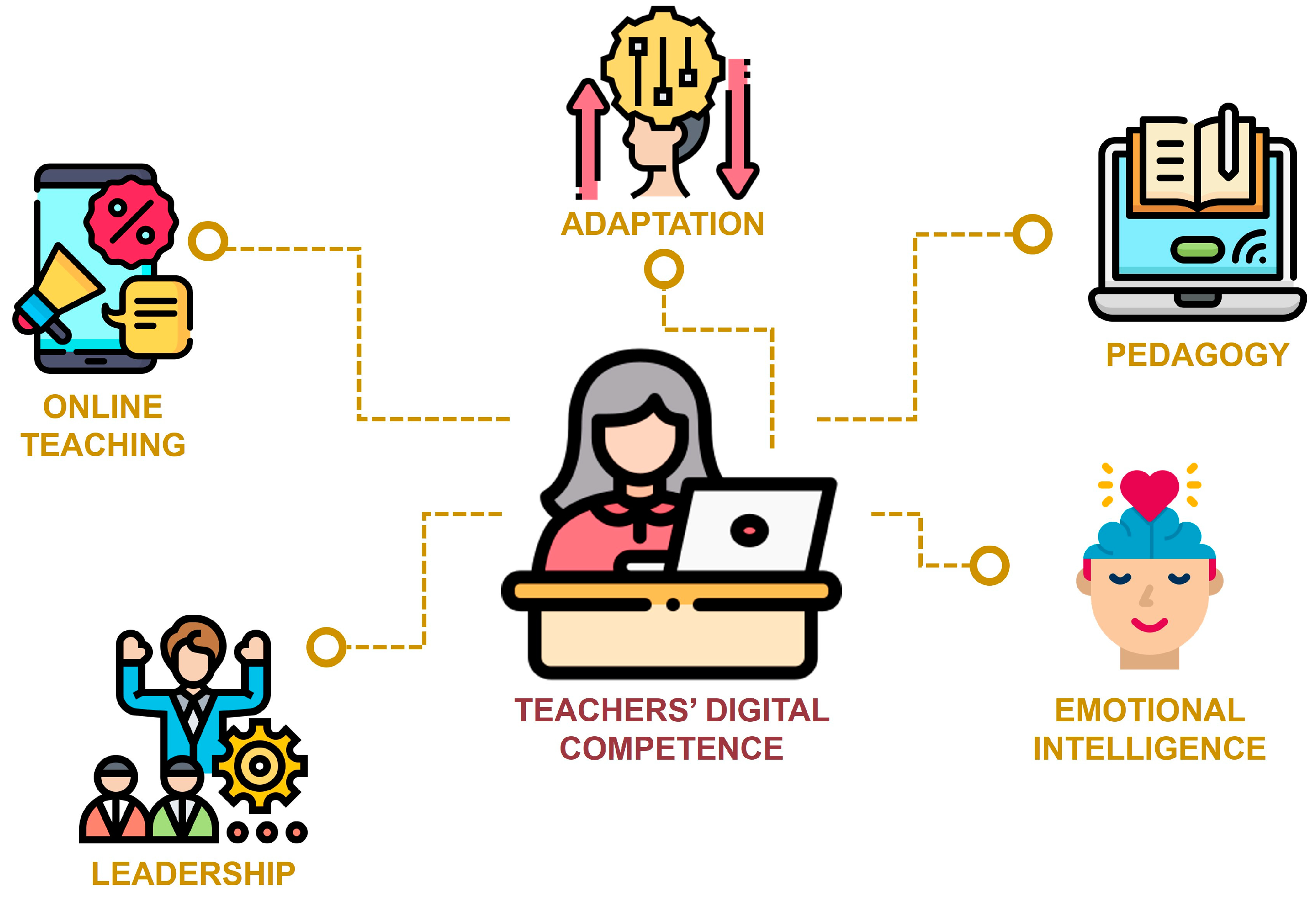
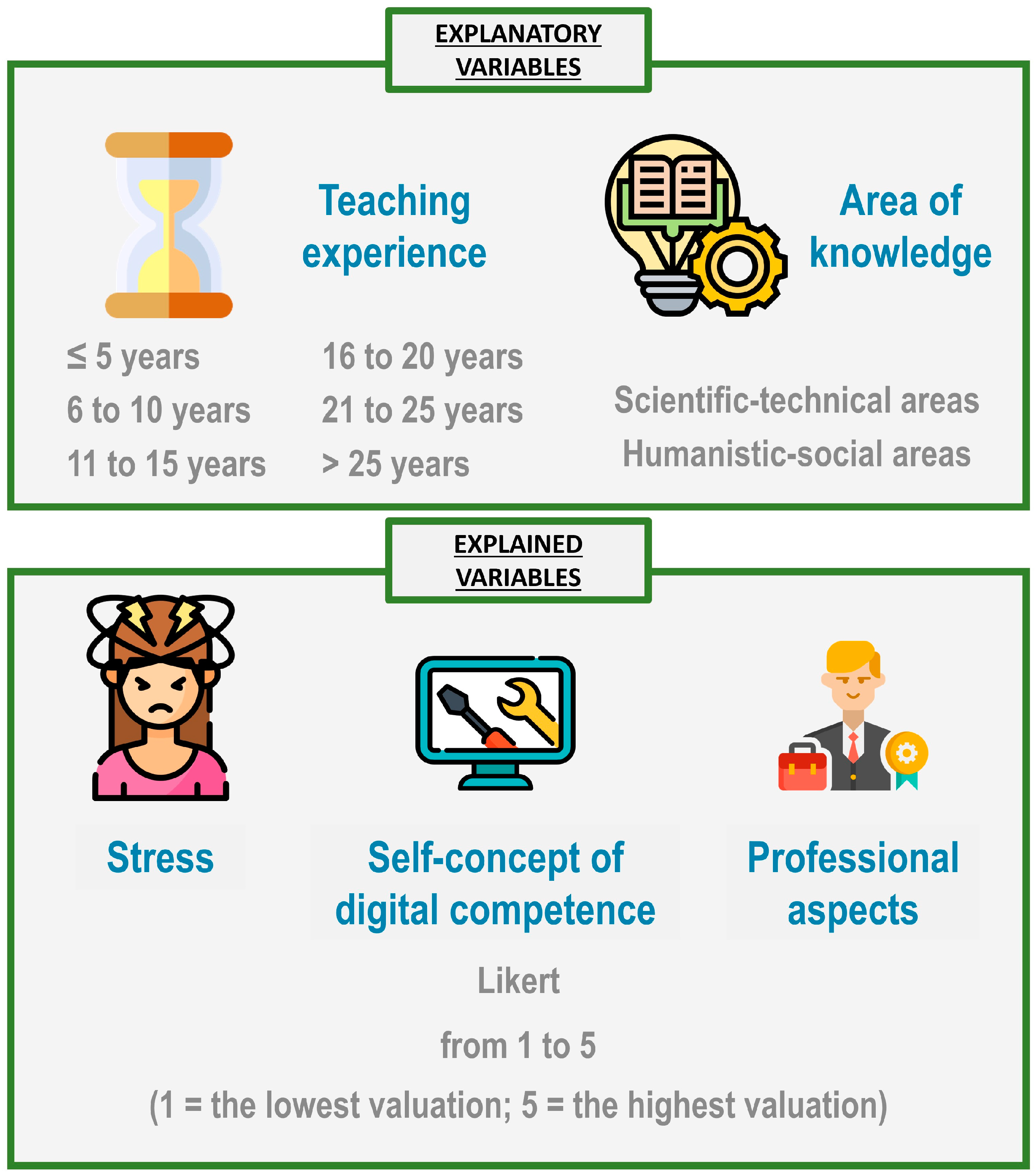
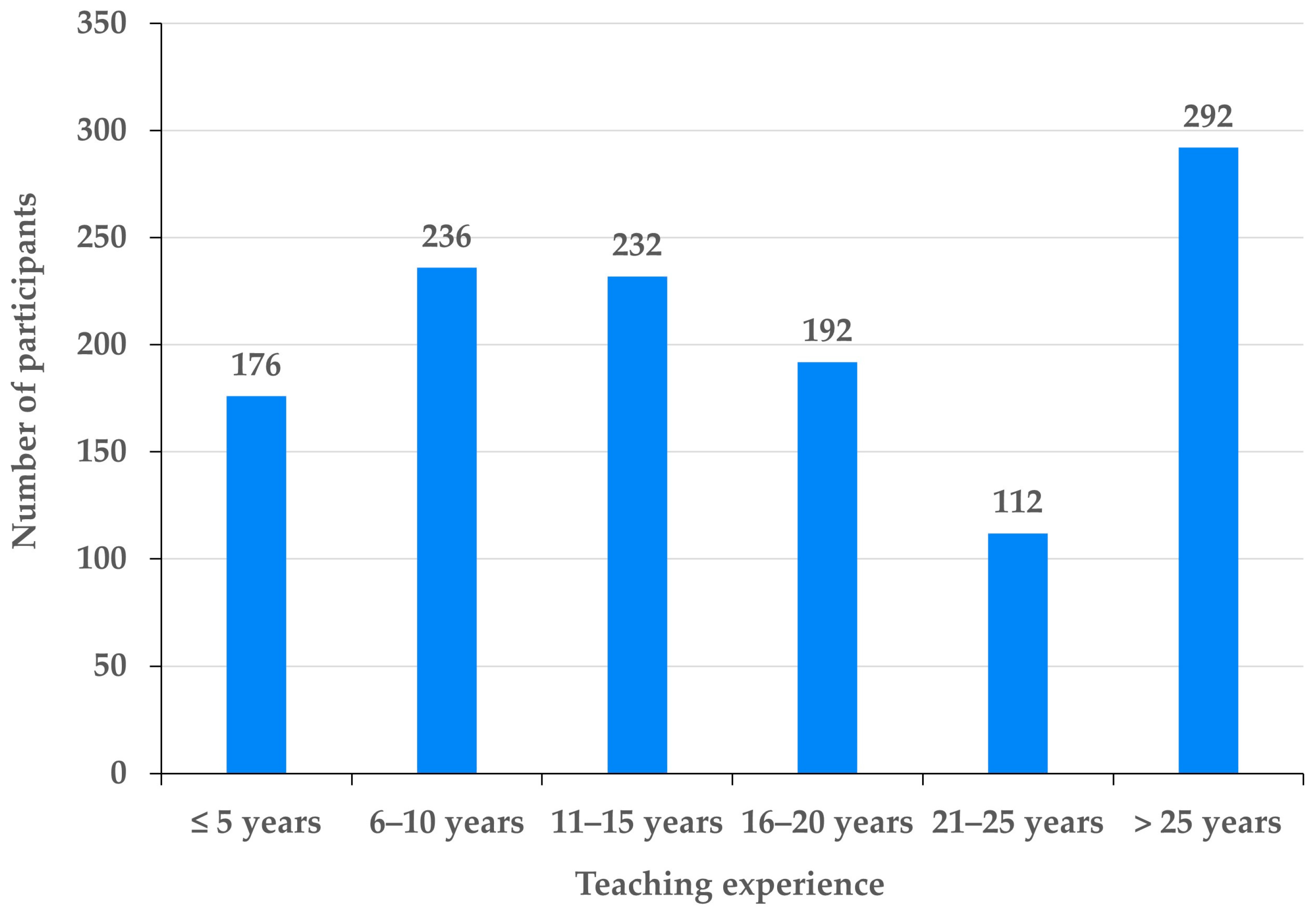
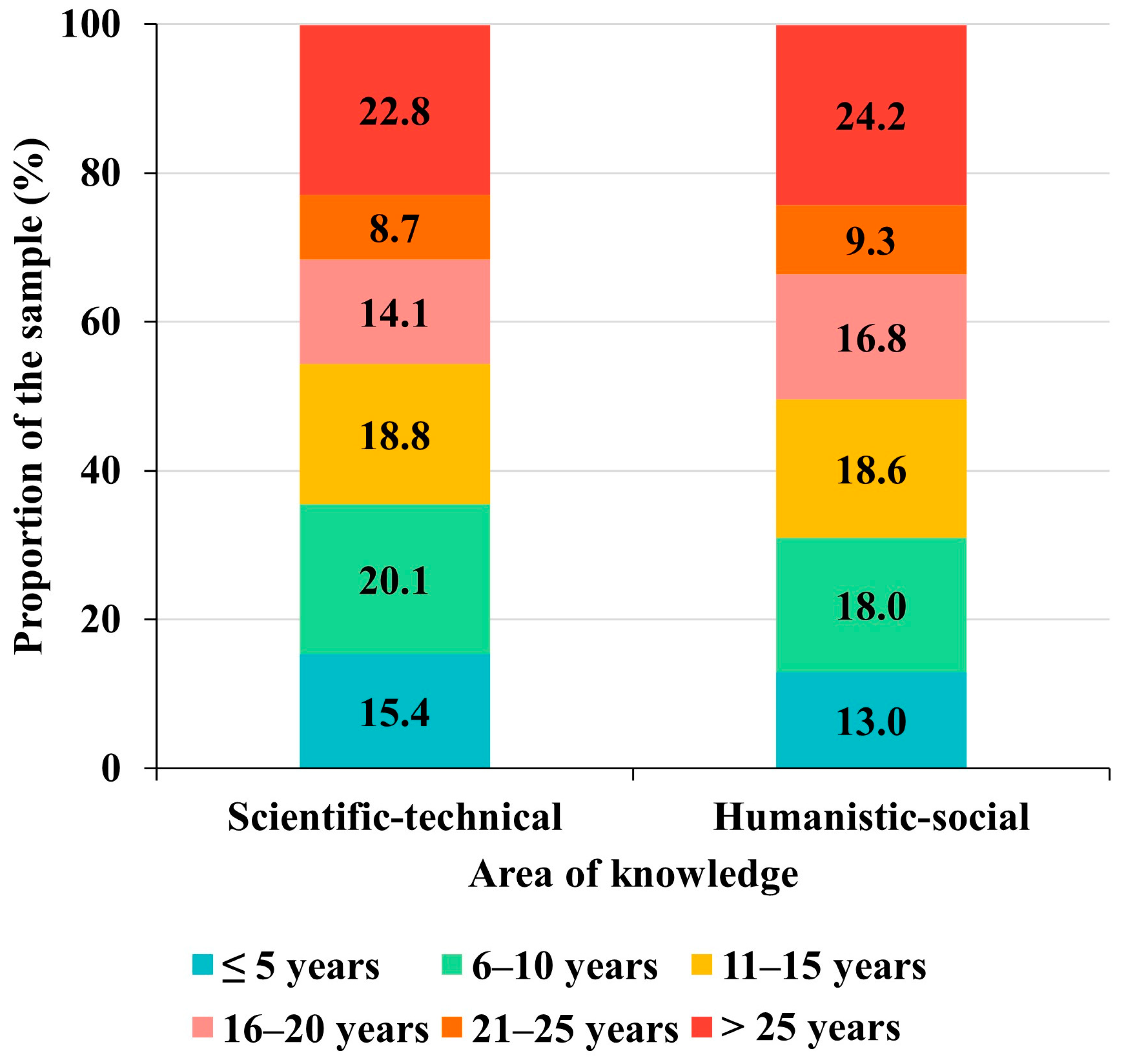

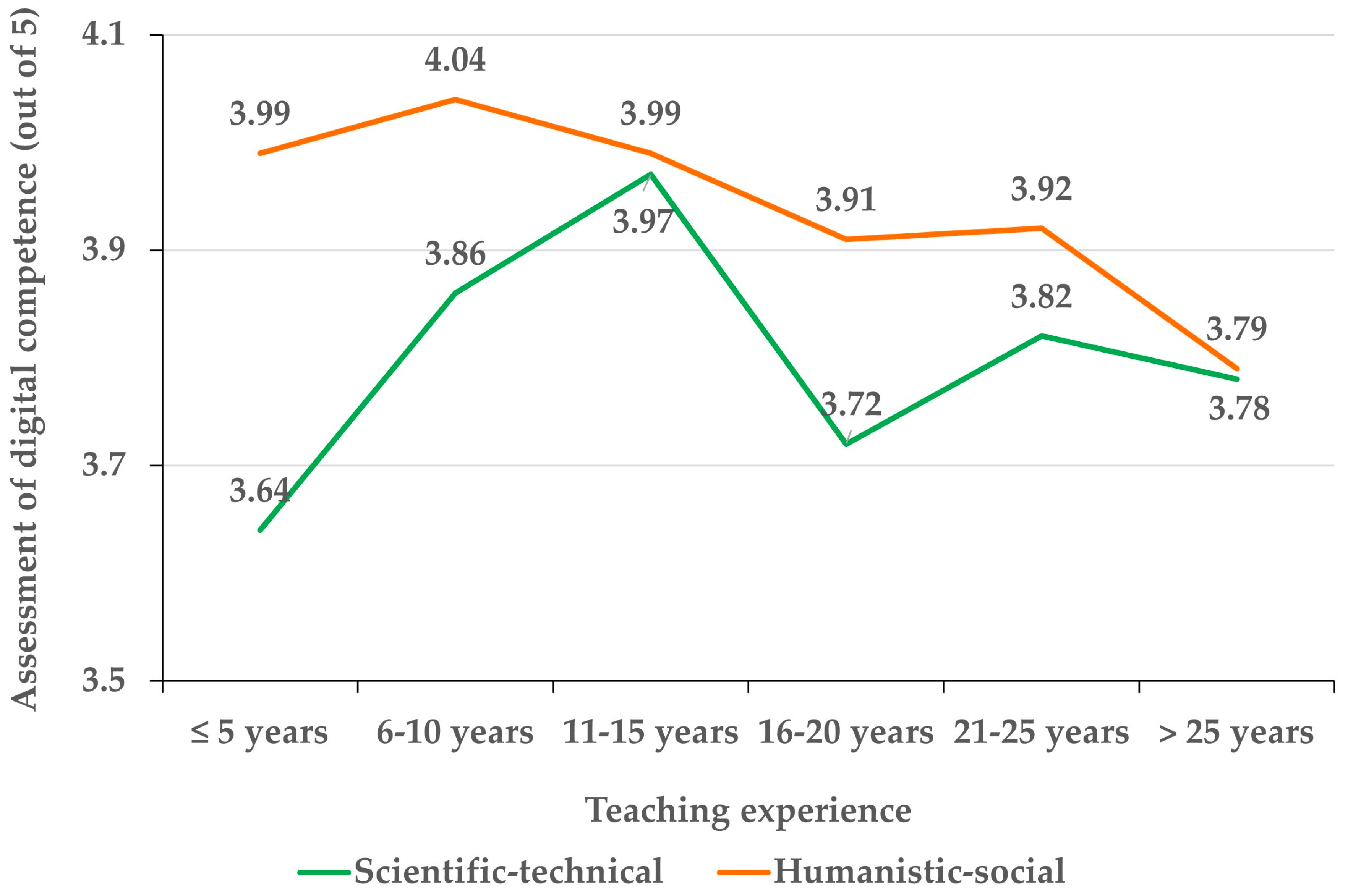
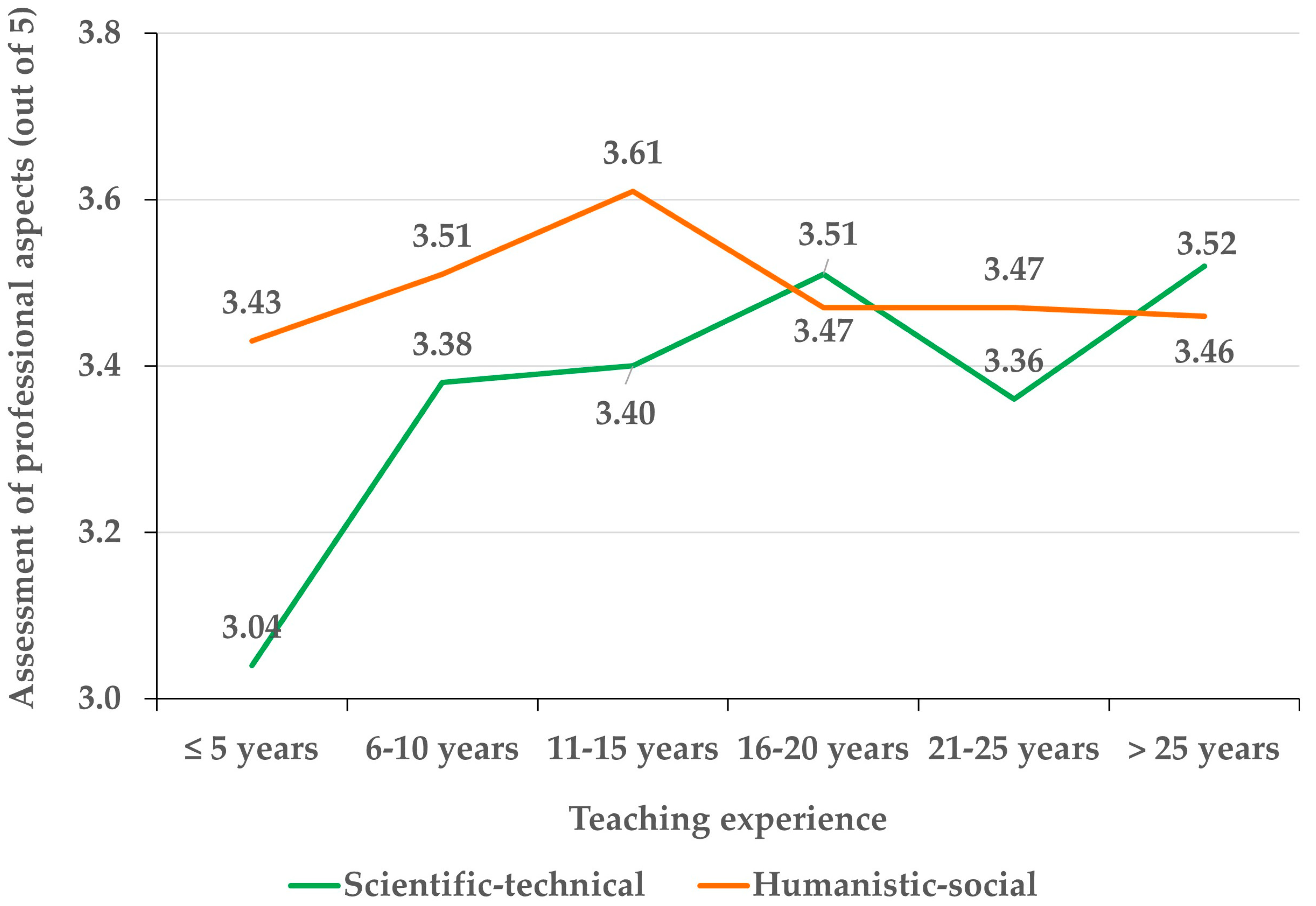
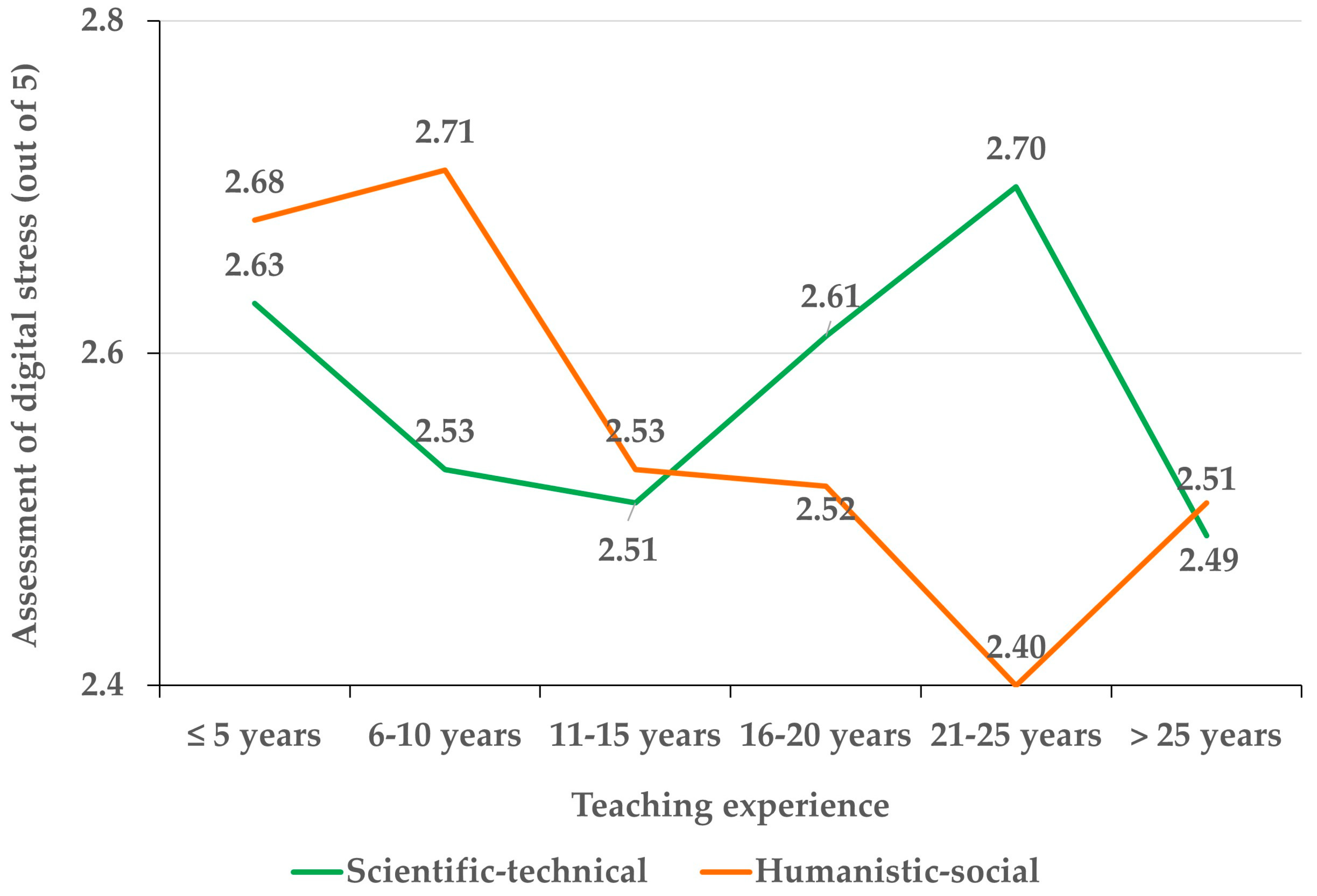
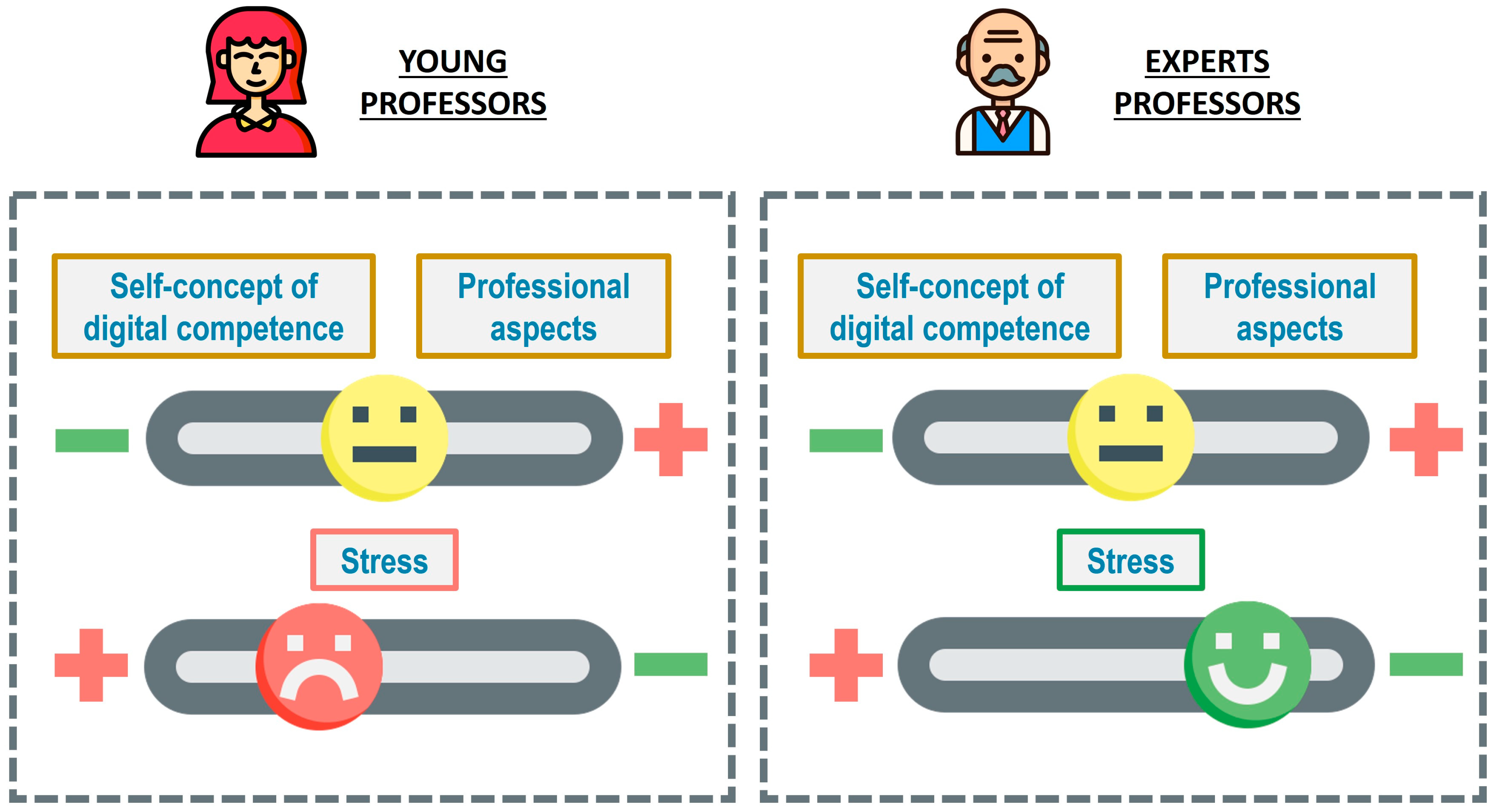
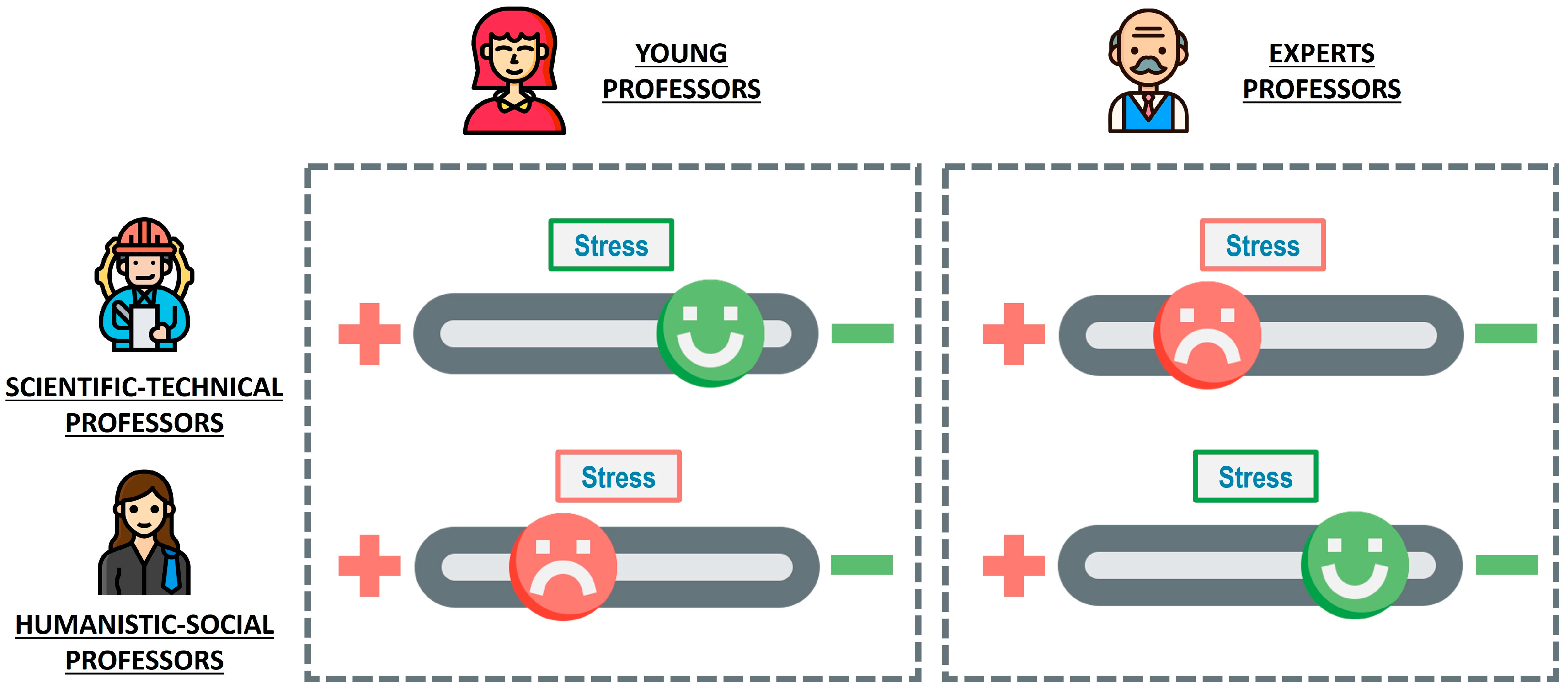
| Country | Proportion of the Sample (%) |
|---|---|
| Argentina | 21.29 |
| Bolivia | 1.29 |
| Brazil | 1.94 |
| Chile | 1.29 |
| Colombia | 9.68 |
| Costa Rica | 0.65 |
| Cuba | 1.29 |
| Dominican Republic | 1.29 |
| Ecuador | 15.48 |
| El Salvador | 1.29 |
| Guatemala | 0.32 |
| Honduras | 1.29 |
| Mexico | 15.16 |
| Nicaragua | 1.61 |
| Panama | 1.29 |
| Paraguay | 0.65 |
| Peru | 10.97 |
| Puerto Rico | 1.29 |
| Uruguay | 0.65 |
| Venezuela | 11.29 |
| Factor | Cronbach’s Alpha | Composite Reliability |
|---|---|---|
| Digital competence | 0.9474 | 0.9372 |
| Professional aspects | 0.7870 | 0.7647 |
| Digital stress | 0.8548 | 0.8329 |
| Factor | Mean | Standard Deviation |
|---|---|---|
| Digital competence | 3.87 | 0.94 |
| Professional aspects | 3.44 | 1.18 |
| Digital stress | 2.56 | 1.24 |
Disclaimer/Publisher’s Note: The statements, opinions and data contained in all publications are solely those of the individual author(s) and contributor(s) and not of MDPI and/or the editor(s). MDPI and/or the editor(s) disclaim responsibility for any injury to people or property resulting from any ideas, methods, instructions or products referred to in the content. |
© 2024 by the authors. Licensee MDPI, Basel, Switzerland. This article is an open access article distributed under the terms and conditions of the Creative Commons Attribution (CC BY) license (https://creativecommons.org/licenses/by/4.0/).
Share and Cite
Fernández-Arias, P.; Antón-Sancho, Á.; Sánchez-Calvo, M.; Vergara, D. Teaching Experience as a Key Factor in Dealing with Digital Teaching Stress. Educ. Sci. 2024, 14, 809. https://doi.org/10.3390/educsci14080809
Fernández-Arias P, Antón-Sancho Á, Sánchez-Calvo M, Vergara D. Teaching Experience as a Key Factor in Dealing with Digital Teaching Stress. Education Sciences. 2024; 14(8):809. https://doi.org/10.3390/educsci14080809
Chicago/Turabian StyleFernández-Arias, Pablo, Álvaro Antón-Sancho, María Sánchez-Calvo, and Diego Vergara. 2024. "Teaching Experience as a Key Factor in Dealing with Digital Teaching Stress" Education Sciences 14, no. 8: 809. https://doi.org/10.3390/educsci14080809
APA StyleFernández-Arias, P., Antón-Sancho, Á., Sánchez-Calvo, M., & Vergara, D. (2024). Teaching Experience as a Key Factor in Dealing with Digital Teaching Stress. Education Sciences, 14(8), 809. https://doi.org/10.3390/educsci14080809









